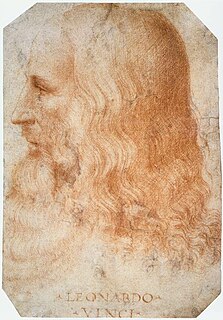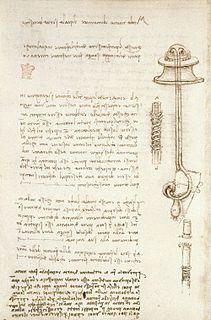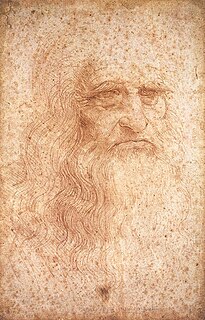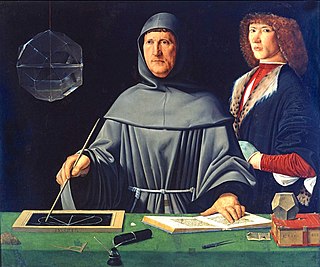
The Mona Lisa is a half-length portrait painting by the Italian Renaissance artist Leonardo da Vinci that has been described as "the best known, the most visited, the most written about, the most sung about, the most parodied work of art in the world." The Mona Lisa is also one of the most valuable paintings in the world. It holds the Guinness World Record for the highest known insurance valuation in history at US$100 million in 1962.

The Last Supper is a late 15th-century mural painting by Italian artist Leonardo da Vinci housed by the refectory of the Convent of Santa Maria delle Grazie in Milan, Italy. It is one of the Western world's most recognizable paintings.

Sfumato is a painting technique for softening the transition between colours, mimicking an area beyond what the human eye is focusing on, or the out-of-focus plane. Leonardo da Vinci was the most prominent practitioner of sfumato, based on his research in optics and human vision, and his experimentation with the camera obscura. He used it in many works, including the Virgin of the Rocks and in his famous painting of the Mona Lisa. He described sfumato as "without lines or borders, in the manner of smoke or beyond the focus plane".

The Virgin of the Rocks is the name of two paintings by Leonardo da Vinci, of the same subject, and of a composition which is identical except for several significant details. The version generally considered the prime version, that is the earlier of the two, is unrestored and hangs in The Louvre in Paris. The other, which was restored between 2008-2010, hangs in the National Gallery, London. The paintings are both nearly 2 metres high and are painted in oils. Both were originally painted on wooden panel, but the Louvre version has been transferred to canvas.

Annunciation is a painting by Italian Renaissance artist Leonardo da Vinci, dating from circa 1472–1475. It is housed in the Uffizi gallery of Florence, Italy.

Saint John the Baptist is a High Renaissance oil painting on walnut wood by Leonardo da Vinci. Probably completed from 1513 to 1516, it is believed to be his final painting. The original size of the painting was 69 × 57 cm. It is now exhibited at the Musée du Louvre in Paris, France.

Leonardo da Vinci was an Italian Renaissance painter and polymath who achieved legendary fame and iconic status within his own lifetime. His renown primarily rests upon his brilliant achievements as a painter, the Mona Lisa and the Last Supper, being two of the most famous artworks ever created, but also upon his diverse skills as a scientist and inventor. He became so highly valued during his lifetime that the King of France bore him home like a trophy of war, supported him in his old age and, according to legend, cradled his head as he died.

The personal life of Leonardo da Vinci has been a subject of interest, inquiry, and speculation since the years immediately following his death. Leonardo has long been regarded as the archetypal Renaissance man, described by the Renaissance biographer Giorgio Vasari as having qualities that "transcended nature" and being "marvellously endowed with beauty, grace and talent in abundance". Interest in and curiosity about Leonardo has continued unabated for five hundred years. Modern descriptions and analysis of Leonardo's character, personal desires and intimate behavior have been based upon various sources: records concerning him, his biographies, his own written journals, his paintings, his drawings, his associates, and commentaries that were made concerning him by contemporaries.

Leonardo da Vinci (1452–1519) was an Italian polymath, regarded as the epitome of the "Renaissance Man", displaying skills in numerous diverse areas of study. Whilst most famous for his paintings such as the Mona Lisa and the Last Supper, Leonardo is also renowned in the fields of civil engineering, chemistry, geology, geometry, hydrodynamics, mathematics, mechanical engineering, optics, physics, pyrotechnics, and zoology.

Leonardo da Vinci and A Memory of His Childhood is a 1910 essay by Sigmund Freud about Leonardo da Vinci. It consists of a psychoanalytic study of Leonardo's life based on his paintings.

Leonardo's Horse is a sculpture that was commissioned of Leonardo da Vinci in 1482 by Duke of Milan Ludovico il Moro, but not completed. It was intended to be the largest equestrian statue in the world, a monument to the duke's father Francesco Sforza. Leonardo did extensive preparatory work for it but produced only a clay model, which was later destroyed.

Codex Arundel, is a bound collection of pages of notes written by Leonardo da Vinci and dating mostly from between 1480 and 1518. The codex contains a number of treatises on a variety of subjects, including mechanics and geometry. The name of the codex came from the Earl of Arundel, who acquired it in Spain in the 1630s. It forms part of the British Library Arundel Manuscripts.

The portrait of a man in red chalk in the Biblioteca Reale, Turin is widely, though not universally, accepted as a self-portrait of Leonardo da Vinci. It is thought that Leonardo da Vinci drew this self-portrait at about the age of 60. The portrait has been extensively reproduced and has become an iconic representation of Leonardo as a polymath or "Renaissance Man". Despite this, some historians and scholars disagree as to the true identity of the sitter.

Gian Giacomo Caprotti da Oreno, better known as Salaì, was an Italian artist and pupil of Leonardo da Vinci from 1490 to 1518. Salaì entered Leonardo's household at the age of ten. He created paintings under the name of Andrea Salaì. He was described as one of Leonardo's students and lifelong servant and is thought by some to be the model for Leonardo's St. John the Baptist and Bacchus.

The Portrait of Luca Pacioli is a painting attributed to the Italian Renaissance artist Jacopo de' Barbari, dating to around 1500 and housed in the Capodimonte Museum, Naples, southern Italy. The painting portrays the Renaissance mathematician Luca Pacioli and may have been painted by his collaborator Leonardo da Vinci. The person on the right has not been identified conclusively, but could be the German painter Albrecht Dürer, whom Barbari met between 1495 and 1500.

Carlo Pedretti was an Italian historian. His area of expertise was the life and works of Leonardo da Vinci. He was a professor of art history and Armand Hammer Chair in Leonardo Studies at the University of California, Los Angeles from 1960 until his retirement in 1993.

Salvator Mundi is a painting by Italian Renaissance artist Leonardo da Vinci dated to c. 1500. Long thought to be a copy of a lost original veiled with overpainting, it was rediscovered, restored, and included in a major Leonardo exhibition at the National Gallery, London, in 2011–12. Although several leading scholars have considered it to be an original work by Leonardo, this attribution has been disputed by other specialists, some of whom posit that he only contributed certain elements.

The Madrid Codices I–II, are two manuscripts by Leonardo da Vinci which were discovered in the Biblioteca Nacional de España in Madrid in 1965 by Dr. Jules Piccus, Language Professor at the University of Massachusetts. The Madrid Codices I was finished during 1490 and 1499, and II from 1503 to 1505.





















